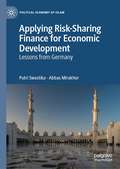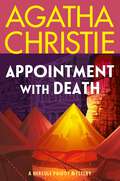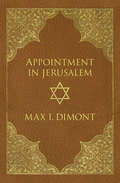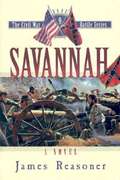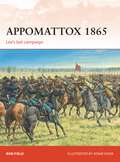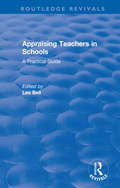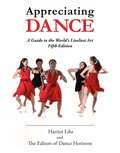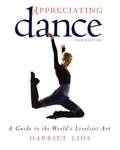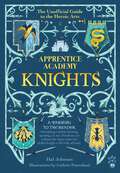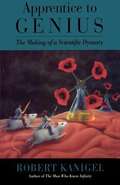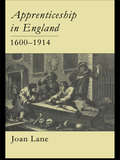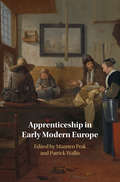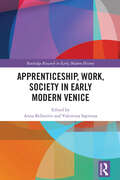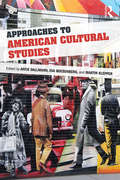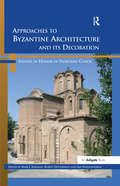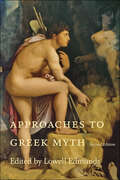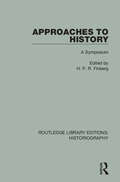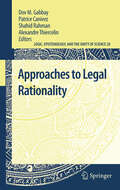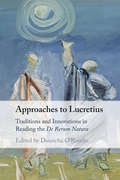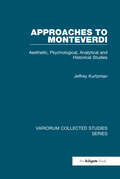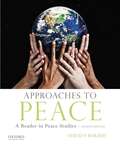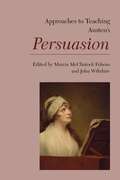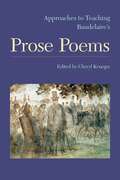- Table View
- List View
Applying Risk-Sharing Finance for Economic Development: Lessons from Germany (Political Economy of Islam)
by Abbas Mirakhor Putri SwastikaThis book examines the application of risk-sharing finance as a national economic policy in history and how it stimulated economic recovery during a short period in Germany between 1933 and 1935. Economic history indicates that risk-sharing instruments have promoted socio-economic development in many parts of the world while risk-shifting methods have imposed huge socio-economic costs on many nations, leading to debt slavery on individual members. This book highlights lessons to be learned from history and argues that risk-sharing is a powerful tool for generating rapid economic recovery and resumption of growth.
Appointment With Death: Hercule Poirot Investigates (Hercule Poirot Mysteries #19)
by Agatha ChristieHercule Poirot may be on vacation, but a killer isn't. The victim's a hateful tourist despised even by her own children. For the guests at the resort hotel, sympathies are with the murderer, which means a tough job for the Belgian detective.
Appointment in Jerusalem: A Search for the Historical Jesus
by Max I. DimontThe acclaimed author of Jews, God, and History considers the historical Jesus &“in the spirited, witty, fascinating manner in which his scholarship excels&” (Bookviews). Biblical historian Max Dimont, author of the classic Jews, God, and History, explores the mystery surrounding the predictions Jesus made about his fate. Examining the gospel, Dimont re-creates the drama in three acts using his knowledge of the events recorded in the Bible. Thoughtful and fascinating, Appointment in Jerusalem examines the questions that have surrounded religion for centuries. Who was Jesus, the Christian messiah or a member of a Jewish sect? Dimont&’s insight is intelligent and surprising.
Appomattox (The Civil War Battle Series, Book #10)
by James Reasoner[From the back cover] As the sun rose in the sky and approached high noon, skirmishes broke out around the village of Appomattox Court House itself. The Yankees were crowding the embattled Confederates on all sides. Mac heard the nearby firing and stood up. Patrick Malone and his sister, Kathleen, had gone back into the house earlier. Now, as they tried to rush out to see what was going on, disregarding their mother's order to stay inside, Mac moved to block their path. He stood in the doorway. "Go on back, children. This is no place for you." He glanced over his shoulder and saw both Confederate and Union soldiers running through the fields. They stopped behind trees and rock fences and took potshots at each other. The shooting was sporadic, but even so, men on both sides were hit. They stood up, cried out, died. Mac's heart pounded as he watched the skirmish. Suddenly, several Yankees came running around the corner of the house. One of them saw Mac standing there in his cavalry uniform, skidded to a stop, and threw his rifle on his shoulder. Mac stood still. He heard a step behind him, and Norah Malone said, "Major ...?" He put out a hand, motioning for her to stop where she was, but he never took his eyes off the Yankee who was drawing a bead on him. The soldier was a grizzled old-timer with more gray in his beard than black. Probably he had been a member of the regular army before the war, and he had fought and survived all the way through four years of combat. Mac met his gaze steadily as the Yankee peered at him over the barrel of the rifle.
Appomattox 1865: Lee's Last Campaign
by Adam Hook Ron FieldFrom an internationally renowned expert on US history, this highly illustrated title details the curtain-closing campaign of the Civil War in the East. Ulysses S. Grant's Army of the Potomac and Robert E. Lee's Army of Northern Virginia faced up to one another one last time, as Lee conducted a desperate series of withdrawals and retreats down the line of Richmond and Danville Railroad. This book, drawing on the detailed visual aid of bird's eye views and maps, tells the full story of the skirmishes and pursuits that led directly to Lee's surrender, as his frantic efforts to extricate his forces from ever more perilous positions became increasingly untenable.
Appraising Teachers in Schools: A Practical Guide (Routledge Revivals)
by Les BellOriginally published in 1988, Appraising Teachers in Schools considers and provides advice on the introduction of staff appraisal in schools. Following the publication of the 1987 Pay and Conditions of Employment and written by contributors with practical experience of introducing staff appraisal into schools, the book provides guidance on the introduction of staff appraisal across a range of schools; outlines a planning process for the establishment of staff appraisal; and offers suggestions for how to prepare for the appraisal process. It covers both primary and secondary education in a variety of larger and smaller schools. Appraising Teachers in Schools will appeal to those with an interest in the history of education and the history of staff appraisal in schools in particular.
Appreciating Dance: A Guide To The World's Liveliest Art
by Dance Horizons Editors Harriet LihsAppreciating Dance is a thorough and accurate history of various forms of dance, analyzing everything from social dance, and ballet to modern dance, tap, jazz, theatrical dance and contemporary dance. In it readers will find: a brief biography of notable dancers and choreographers; information needed to expand the enjoyment of performance; the intersection of dance and religion; the history of dance through the beginning of the 21st century; and budding dance trends. Every chapter in this fifth edition has been updated and revised with new information, including suggestions for YouTube viewing at the end of each chapter.
Appreciating Dance: A Guide to the World's Liveliest Art
by Harriet R. LihsWritten for the dance novice, this book is a concise, thorough, and accurate history of all forms of dance. It gives a brief biography of many of the notable dancers and choreographers who have contributed to each form of dance, and provides, in a nutshell, the information needed to expand the enjoyment of performance. It also details the history of dance from its earliest beginnings and covers the intersection of dance and religion, social dance, ballet, modern dance, tap, jazz, film dance, and contemporary dance.
Appreciation Post: Towards an Art History of Instagram
by Tara WardWhat does an art history of Instagram look like? Appreciation Post reveals how Instagram shifts long-established ways of interacting with images. Tara Ward argues Instagram is a structure of the visual, which includes not just the process of looking, but what can be seen and by whom. She examines features of Instagram use, including the effect of scrolling through images on a phone, the skill involved in taking an "Instagram-worthy" picture, and the desires created by following influencers, to explain how the constraints imposed by Instagram limit the selves that can be displayed on it. The proliferation of technical knowledge, especially among younger women, revitalizes on Instagram the myth of the masculine genius and a corresponding reinvigoration of a masculine audience for art. Ward prompts scholars of art history, gender studies, and media studies to attend to Instagram as a site of visual expression and social consequence. Through its insightful comparative analysis and acute close reading, Appreciation Post argues for art history’s value in understanding the contemporary world and the visual nature of identity today.
Apprentice Academy: The Unofficial Guide to the Heroic Arts (Apprentice Academy)
by Hal JohnsonCongratulations on your acceptance to the Apprentice Academy, one of the world’s finest institutions for knightly education. Your course of study here will prepare you for a career as a knight, samurai, Viking, or really any type of sword-swinging warrior. Swinging a sword is inherently dangerous, but this guide will help you complete your education while minimizing the twin risks of 1. getting maimed and 2. working too hard.Learn how to:• Fight people!• Fight dragons!• Fight monsters!• Fight everything else!• Die honorably!• And more!Please follow all instructions carefully. If you go off on your own and try something silly, and then get your head chopped off or your body bitten in two, don’t start drafting a letter of complaint. You had fair warning.
Apprentice To Genius: The Making Of A Scientific Dynasty
by Robert KanigelRobert Kanigel takes us into the heady world of a remarkable group of scientists working at the National Institutes of Health and the Johns Hopkins University: a dynasty of American researchers who for over forty years have made Nobel Prize- and Lasker Award-winning breakthroughs in biomedical science.
Apprenticeship In England, 1600-1914
by Joan LaneFirst published in 1996. Routledge is an imprint of Taylor & Francis, an informa company.
Apprenticeship in Early Modern Europe
by Maarten Prak Patrick WallisThis is the first comparative and comprehensive account of occupational training before the Industrial Revolution. Apprenticeship was a critical part of human capital formation, and, because of this, it has a central role to play in understanding economic growth in the past. At the same time, it was a key stage in the lives of many people, whose access to skills and experience of learning were shaped by the guilds that trained them. The local and national studies contained in this volume bring together the latest research into how skills training worked across Europe in an era before the emergence of national school systems. These essays, written to a common agenda and drawing on major new datasets, systematically outline the features of what amounted to a European-wide system of skills education, and provide essential insights into a key institution of economic and social history.
Apprenticeship, Work, Society in Early Modern Venice
by Anna Bellavitis Valentina SapienzaApprenticeship in early modern Europe has been the subject of important research in the last decades, mostly by economic historians, but the majority of the research has dealt with cities or countries in Northern Europe. The organization, evolution and purpose of apprenticeship in Southern Europe are much less studied, especially for the early modern period. The research in this volume is based on a unique documentary source: more than 54,000 apprenticeship contracts registered from 1575 to 1772 by the ‘Old Justice’, a civil court of the Republic of Venice in charge of guilds and labour disputes. An archival source of such scale provides a unique opportunity to historians and this is the first time that primary research on apprenticeship is leveraging such a large amount of data in one of the main economic centres of early modern Europe. This book brings together multiple perspectives including social history, economic history and art history and is the outcome of an interdisciplinary collaboration between historians and computer scientists. Apprenticeship, Work, Society in Early Modern Venice will appeal to students and researchers alike interested in the nature of work and employment in Venice and Italy as well as society in Early Modern Europe more generally.
Approaches to American Cultural Studies
by Antje Dallmann Eva Boesenberg Martin KlepperApproaches to American Cultural Studies provides an accessible yet comprehensive overview of the diverse range of subjects encompassed within American Studies, familiarising students with the history and shape of American Studies as an academic subject as well as its key theories, methods, and concepts. Written and edited by an international team of authors based primarily in Europe, the book is divided into four thematically-organised sections. The first part delineates the evolution of American Studies over the course of the twentieth century, the second elaborates on how American Studies as a field is positioned within the wider humanities, and the third inspects and deconstructs popular tropes such as myths of the West, the self-made man, Manifest Destiny, and representations of the President of the United States. The fourth part introduces theories of society such as structuralism and deconstruction, queer and transgender theories, border and hemispheric studies, and critical race theory that are particularly influential within American Studies. This book is supplemented by a companion website offering further material for study (www.routledge.com/cw/dallmann). Specifically designed for use on courses across Europe, it is a clear and engaging introductory text for students of American culture.
Approaches to Byzantine Architecture and its Decoration: Studies in Honor of Slobodan Curcic
by Mark J. Johnson Amy PapalexandrouThe fourteen essays in this collection demonstrate a wide variety of approaches to the study of Byzantine architecture and its decoration, a reflection of both newer trends and traditional scholarship in the field. The variety is also a reflection of Professor Curcic’s wide interests, which he shares with his students. These include the analysis of recent archaeological discoveries; recovery of lost monuments through archival research and onsite examination of material remains; reconsidering traditional typological approaches often ignored in current scholarship; fresh interpretations of architectural features and designs; contextualization of monuments within the landscape; tracing historiographic trends; and mining neglected written sources for motives of patronage. The papers also range broadly in terms of chronology and geography, from the Early Christian through the post-Byzantine period and from Italy to Armenia. Three papers examine Early Christian monuments, and of these two expand the inquiry into their architectural afterlives. Others discuss later monuments in Byzantine territory and monuments in territories related to Byzantium such as Serbia, Armenia, and Norman Italy. No Orthodox church being complete without interior decoration, two papers discuss issues connected to frescoes in late medieval Balkan churches. Finally, one study investigates the continued influence of Byzantine palace architecture long after the fall of Constantinople.
Approaches to Greek Myth
by Lowell EdmundsNow thoroughly revised and updated, this volume offers a variety of historical, comparative, and theoretical perspectives on Greek myth.Since the first edition of Approaches to Greek Myth was published in 1990, interest in Greek mythology has surged. There was no simple agreement on the subject of "myth" in classical antiquity, and there remains none today. Is myth a narrative or a performance? Can myth be separated from its context? What did myths mean to ancient Greeks and what do they mean today? Here, Lowell Edmunds brings together practitioners of eight of the most important contemporary approaches to the subject. Whether exploring myth from a historical, comparative, or theoretical perspective, each contributor lucidly describes a particular approach, applies it to one or more myths, and reflects on what the approach yields that others do not. Edmunds's new general and chapter-level introductions recontextualize these essays and also touch on recent developments in scholarship in the interpretation of Greek myth. Contributors are Jordi Pàmias, on the reception of Greek myth through history; H. S. Versnel, on the intersections of myth and ritual; Carolina López-Ruiz, on the near Eastern contexts; Joseph Falaky Nagy, on Indo-European structure in Greek myth; William Hansen, on myth and folklore; Claude Calame, on the application of semiotic theory of narrative; Christiane Sourvinou-Inwood, on reading visual sources such as vase paintings; and Robert A. Segal, on psychoanalytic interpretations.
Approaches to Greek Myth
by Lowell Edmunds“A handy introduction to some of the more useful methodological approaches to and the previous scholarship on the subject of Greek myths.” —PhoenixSince the first edition of Approaches to Greek Myth was published in 1990, interest in Greek mythology has surged. There was no simple agreement on the subject of “myth” in classical antiquity, and there remains none today. Is myth a narrative or a performance? Can myth be separated from its context? What did myths mean to ancient Greeks and what do they mean today?Here, Lowell Edmunds brings together practitioners of eight of the most important contemporary approaches to the subject. Whether exploring myth from a historical, comparative, or theoretical perspective, each contributor lucidly describes a particular approach, applies it to one or more myths, and reflects on what the approach yields that others do not. Edmunds’s new general and chapter-level introductions recontextualize these essays and also touch on recent developments in scholarship in the interpretation of Greek myth.Contributors are Jordi Pàmias, on the reception of Greek myth through history; H. S. Versnel, on the intersections of myth and ritual; Carolina López-Ruiz, on the near Eastern contexts; Joseph Falaky Nagy, on Indo-European structure in Greek myth; William Hansen, on myth and folklore; Claude Calame, on the application of semiotic theory of narrative; Christiane Sourvinou-Inwood, on reading visual sources such as vase paintings; and Robert A. Segal, on psychoanalytic interpretations.“A valuable collection of eight essays . . . Edmunds’s book provides a convenient opportunity to grapple with the current methodologies used in the analysis of literature and myth.” —New England Classical Newsletter and Journal
Approaches to History: A Symposium (Routledge Library Editions: Historiography)
by H. P. FinbergThe contributors to this volume, originally published in 1962, explain the raison d’être of their own specialism in history be it archaeology, political, local, economic or social history or historical geography.
Approaches to Legal Rationality (Logic, Epistemology, and the Unity of Science #20)
by Dov M. Gabbay Patrice Canivez Shahid Rahman Alexandre ThiercelinLegal theory, political sciences, sociology, philosophy, logic, artificial intelligence: there are many approaches to legal argumentation. Each of them provides specific insights into highly complex phenomena. Different disciplines, but also different traditions in disciplines (e.g. analytical and continental traditions in philosophy) find here a rare occasion to meet. The present book contains contributions, both historical and thematic, from leading researchers in several of the most important approaches to legal rationality. One of the main issues is the relation between logic and law: the way logic is actually used in law, but also the way logic can make law explicit. An outstanding group of philosophers, logicians and jurists try to meet this issue. The book is more than a collection of papers. However different their respective conceptual tools may be, the authors share a common conception: legal argumentation is a specific argumentation context.
Approaches to Lucretius: Traditions and Innovations in Reading the De Rerum Natura
by Donncha O’RourkeBoth in antiquity and ever since the Renaissance Lucretius' De Rerum Natura has been admired – and condemned – for its startling poetry, its evangelical faith in materialist causation, and its seductive advocacy of the Epicurean good life. Approaches to Lucretius assembles an international team of classicists and philosophers to take stock of a range of critical approaches to which this influential poem has given rise and which in turn have shaped its interpretation, including textual criticism, the text's strategies for engaging the reader with its author and his message, the 'atomology' that posits a correlation of the letters of the poem with the atoms of the universe, the literary and philosophical intertexts that mediate the poem, and the political and ideological questions that it raises. Thirteen essays take up a variety of positions within these traditions of interpretation, innovating within them and advancing beyond them in new directions.
Approaches to Monteverdi: Aesthetic, Psychological, Analytical and Historical Studies (Variorum Collected Studies)
by Jeffrey KurtzmanThis volume gathers together twelve essays on the composer’s music, reflecting the author's interests in aesthetic and psychological issues, the sacred works, methods of structural analysis, and the problems of making critical editions. The opera Orfeo and two madrigals from Monteverdi's Book Eight are the subject of aesthetic and psychological investigation, especially from the perspective of Michel Foucault's The Order of Things and the psychology of C.J. Jung, all supported by musical analysis. Two essays analyze in detail the structural principles of the psalms Laetatus sum from the 1610 Vespers and the first Dixit Dominus from the Sevla Morale e spirituale of 1641. Two others re-examine the story of Monteverdi's Mass of Thanksgiving and consider the question of what sacred music Monteverdi actually or likely wrote but is now lost. The final essay critiques and compares the methodology and problems of the Malipiero and Cremona editions of Monteverdi's Opera Omnia. All but one of these essays were originally published over a time span of twenty years in journals, conference reports, Festschriften, and as book chapters. The majority of them were not widely distributed or readily available until now. The essay on the Malipiero and Cremona editions appears here for the first time.
Approaches to Peace: A Reader in Peace Studies
by David P. BarashApproaches to Peace: A Reader in Peace Studies, Fourth Edition, provides a unique and interdisciplinary sampling of key articles focusing on the diverse facets of peace and conflict studies. Featuring both classic and contemporary work, it enables students to read highly influential articles while also introducing them to the most current perspectives in the field. Timeless classics from Leo Tolstoy, Martin Luther King, Jr., Gandhi, and Henry David Thoreau are included alongside contemporary pieces by illustrious contributors including Noam Chomsky, bell hooks, Vandana Shiva, and Pope Francis.
Approaches to Teaching Austen's Persuasion (Approaches to Teaching World Literature #166)
by John Wiltshire Marcia M. FolsomJane Austen is a favorite with many students, whether they've read her novels or viewed popular film adaptations. But Persuasion, completed at the end of her life, can be challenging for students to approach. They are surprised to meet a heroine so subdued and self-sacrificing, and the novel's setting during the Napoleonic wars may be unfamiliar. This volume provides teachers with avenues to explore the depths and richness of the novel with both Austen fans and newcomers.Part 1, "Materials," suggests editions for classroom use, criticism, and multimedia resources. Part 2, "Approaches," presents strategies for teaching the literary, contextual, and philosophical dimensions of the novel. Essays address topics such as free indirect discourse and other narrative techniques; social class in Austen's England; the role of the navy during war and peacetime; key locations in the novel, including Lyme Regis and Bath; and health, illness, and the ethics of care.
Approaches to Teaching Baudelaire's Prose Poems (Approaches to Teaching World Literature #142)
by Cheryl KruegerA prolific poet, art critic, essayist, and translator, Charles Baudelaire is best known for his volumes of verse (Les Fleurs du Mal [Flowers of Evil]) and prose poems (Le Spleen de Paris [Paris Spleen]). This volume explores his prose poems, which depict Paris during the Second Empire and offer compelling and fraught representations of urban expansion, social change, and modernity. Part 1, "Materials," surveys the valuable resources available for teaching Baudelaire, including editions and translations of his oeuvre, historical accounts of his life and writing, scholarly works, and online databases. In Part 2, "Approaches," experienced instructors present strategies for teaching critical debates on Baudelaire's prose poems, addressing topics such as translation theory, literary genre, alterity, poetics, narrative theory, and ethics as well as the shifting social, economic, and political terrain of the nineteenth century in France and beyond. The essays offer interdisciplinary connections and outline traditional and fresh approaches for teaching Baudelaire's prose poems in a wide range of classroom contexts.
